Still reaching for the stars
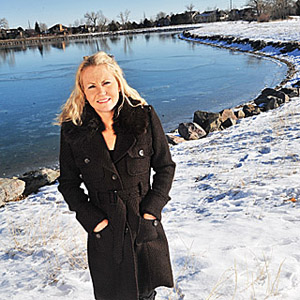
Mary Beth Ellis loved virtually every sport from the time she could walk. At the age of three, video recorded her running full tilt down the aisle at her aunt's wedding. As a kid she threw herself in swimming, sailing, golf, tennis and soccer — and gymnastics, tap, ballet, jazz dancing and baton twirling. She also excelled at softball, field hockey and lacrosse. No organized ice hockey, but near her home in Delaware there was an ice pond where she, her brother and occasional neighbors whaled away with hockey sticks at cans of tuna that substituted for a puck.
Eventually she gravitated to swimming and running. As a freshman at Northwestern, she qualified for the 1996 Olympic Trials in the 100-meter breaststroke, falling in the prelims. Undaunted, she competed in cross country and track as a junior and broke 17 minutes for the 5k. After graduating in industrial engineering and economics and enrolling for a masters degree in marketing at Northwestern, she pursued distance running and placed high in several half marathons. With a 2:41 at the Philadelphia Marathon, she met the 2004 Olympic Trials qualifying standard. But beset by injuries, she could not compete. A year later, she took up triathlon and won her first race.
After falling short of qualifying for the 2008 Olympics, she found her strength in triathlon's longer distances, winning medals at the 2008 and 2009 Ironman 70.3 World Championships. Five years after turning pro, she entered the rarefied air of elite Ironman triathletes with three straight wins, setting a record for the fastest Ironman debut by a woman. But the road through all of these highlights was always tough, as the very resolute Mary Beth Ellis suffered through shin splints, stress fractures, labrum tears, metatarsal capsule tears, and bouts of overtraining syndrome that would have crushed a lesser spirit.
One thing she learned along the way was to take time to simply enjoy life. And so she and Eric Olsen gathered a merry mob of family and friends to their snow-blessed wedding this month in Beaver Creek, Colorado. A few weeks later, Mary Beth took time to reflect on her triathlon odyssey.
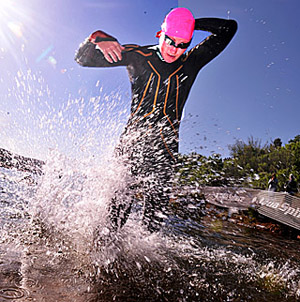
Slowtwitch: How did you evolve into a triathlete"
Mary Beth Ellis: In 2005, I was living in Denver and working in the marketing department of an internet retailer. I had recently been diagnosed with arthritis and decided to give up distance road racing and its 80 to 100 mile weeks because I didn’t want to end up with replacement hips in my 30s. I could not run for 4-6 weeks so I started doing some swimming and biking to keep fit and decided that would go better if I moved to Boulder. A couple of guys I worked with did triathlons and they suggested doing some of the masters swim workouts. While I hadn’t been running, doing a triathlon seemed like a good idea because I had a big endurance base and figured I could get through the run.
ST: How did your first race go?
Mary Beth: I placed was first overall amateur woman at Boulder Peak. I was just 40 seconds behind Amanda Lovato, who won overall, and that put the thought in my head to turn pro. I needed to do well at two more races to meet the standard. So I won the Race For the Cure in Denver and finished third at a triathlon in Delaware in October and that was enough to get my pro license.
ST: When did you get a coach?
Mary Beth: I started with Siri Lindley early in 2006. She had a nice group of athletes in Boulder and a lot of those people went on to great things. Sarah Groff is a 2012 Olympian and Lauren Groves Campbell raced for Canada at the 2008 Olympics. I was skiing when they were still at training camp in Australia and I fell and hurt myself, so that pushed back my start. It was good in some ways, because Siri started with working on my bike and my swim — the two areas where I needed the most improvement.
ST: How was it working with her?
Mary Beth: I learned a ton. You couldn’t ask for a better first coach. I was so green I didn’t know how to mount a bike or any of these little things that are pretty basic. She is so enthusiastic — and pretty tough. You need a coach like that. If they are just your buddy it's not going to work. You need somebody who is going to push you.
ST: How was your first year racing pro?
Mary Beth: I had a good first year. I was focusing on ITU races and I got a 3rd at the Continental Cup at in Brampton, Ontario and I won the Continental Cup at Kelowna, British Columbia. I was also second at Boulder Peak and second in LA.
ST: So what did you do for an encore?
Mary Beth: 2007 wasn’t a great year. I had had a torn labrum back when I was running marathons and in 2005 I had been diagnosed with the arthritis in my right hip. Leading up to the 2007 season, I developed an injury on the other hip, my left. The bad thing was I injured it just before going to Australia for training camp. I went anyway and I tried to force it. It was pretty painful. I’d just left my job so I was questioning my decision to become a full time professional triathlete.
ST: How long before you were back racing?
Mary Beth: I got fully healthy around May and did ITU World Cups in Portugal and South Africa.
ST: In World Cup racing, the measure of potential is the run. What were your 10k times?
Mary Beth: As I went along, I did some in 37, one at 38 and one in 36. I think I never really got any faster than 36. To be really competitive at the Olympic distance, you need to be faster.
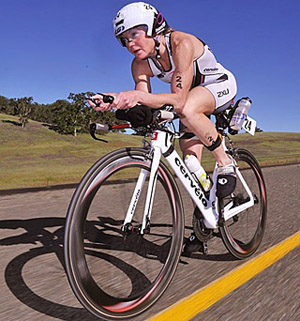
ST: As 2007 ended, you focused on trying to make the US women's Olympic team. Did you race the first US Trials event, the 2007 Beijing World Cup ?
Mary Beth: No, but I did race the next two early in 2008. At that time, I was on the bubble — you had to be ranked in the top 120 in ITU points to make the trials. So I did World Cups in Australia and New Zealand a month before the last two trials races, which gave me enough points. Things were going well until New Zealand when Lisa Hutthaler crashed and took out Kate Allen. I was following Kate and I flew through the air and rolled. Most of my damage was just road rash. But my hands were hurting so bad, I could not swim for the two weeks leading up to the first trials event. For me, getting to the front pack of the swim was going to be huge issue as it was. But not swimming for two weeks didn’t help.
ST: At the two remaining US Olympic Trials events, you got 6th in Tuscaloosa and also at Hy-Vee?
Mary Beth: I got 11th overall and I was the 6th American at Hy-Vee. I was a minute and half down on the first lap and I had to kill myself to catch the front pack on the bike. By the time I finished the bike, I didn’t have much left.
ST: When did you go up in distance?
Mary Beth: My first Ironman 70.3 was Lake Stevens later that summer, which I won. It isn’t a super fast run course and I think I ran a 1:27 there. That was one of those races I spent all on my own. It gave me confidence I could finish well regardless of the way the race played out.
ST: You had a career breakthrough silver medal at the 2008 Ironman 70.3 World Championship where you had an excellent swim and bike.
Mary Beth: Joanna Zeiger, Julie Dibens, Becky Lavelle and I came off the bike in the first group. Joanna took off the front immediately. I started at the back, and passed Julie and Becky on the first lap.
ST: You ran 1:23 and finished 2nd behind Zeiger. Were you surprised?
Mary Beth: It was definitely thrilling and unexpected.
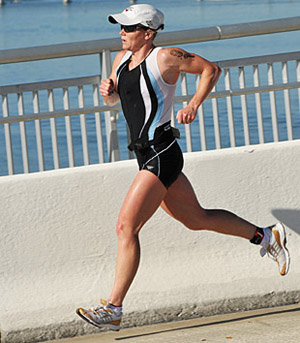
ST: In fact your running stride at Clearwater was picture perfect and reminded me of your remarks on John Keats' famous poem "Ode to a Grecian Urn."
Mary Beth: I had an inspiring English teacher in high school, Katherine Mittnacht, who was so animated, so enthusiastic. I remember reading that poem in which Keats contemplated the timeless beauty of Greek paintings of athletes frozen in time. I took from it that the best part of the race, and life, is that moment of ecstasy reaching for the unattainable goal.
ST: From that point though 2010, you struggled with more injuries.
Mary Beth: My 2009 season started out great [Ellis won Escape From Alcatraz and the Pan Am Championships] and then in July I had a plantar plate tear on the second metatarsal of my left foot. Apparently I like to even myself out — early in 2010 I sustained the same injury to my right foot.
ST: What set those off?
Mary Beth: I was wearing racing flats that were slightly small and my toes were shoved in them. Sort of the same injury, but to a lesser degree, than Julie Dibens' toe. Like Julie, I have Morton's toe, which is a longer than average second toe. She has it much worse than I, and she finally had surgery this year. In 2009, I was happy to recover enough to finish second [to Dibens] again at Clearwater.
ST: 2010 was a very hard year.
Mary Beth: After Clearwater I spent December of 2009 and January of 2010 thinking I was going to have this long layoff and then have surgery on a small tear in the joint capsule of the second metatarsal. Two doctors said I should have surgery. The third doctor said not to. So I waited on surgery and never took much of a break.
ST: How did you weigh the risks?
Mary Beth: The risk is what happened to Julie. It might start to dislocating. When it starts dislocating, you have to have surgery. There is no option. In my case I was able to adapt and things got better for 2011. If I had opted for the operation as a preventative measure, I ran the risk of complications.
ST: In dark moments did you fear you might have to retire?
Mary Beth: Not because of that injury. I was pretty healthy early in 2010. But I was racing poorly. I think I was overtrained.
ST: What effect did it have on you mentally and emotionally?
Mary Beth: I think as you have bad races it becomes a confidence issue and there is a spiral effect. When you have more bad races you go back and train harder. The problem gets worse and your tailspin gets deeper. I was training harder than I had in my life and things were getting worse and worse.
ST: When did you tell yourself to stop the madness?
Mary Beth: I flew in sick to the 2010 ITU World Championship Series Grand Final in Budapest. It was raining and cold and I got sicker and then I had an awful race [48th].
ST: What did you do next?
Mary Beth: I had all the classic over training symptoms and it got to the point where I wasn’t motivated to train. So I went to the doctor and had all the blood work run. I had elevated liver enzymes and all sorts of wacky things that indicated I needed rest. So the next month I just did easy aerobic stuff. I did feel a lot better, but as I was trying to come back for Clearwater, I had a stress reaction to in my hips that was a precursor to a stress fracture. I decided to call it a year and took six weeks off.
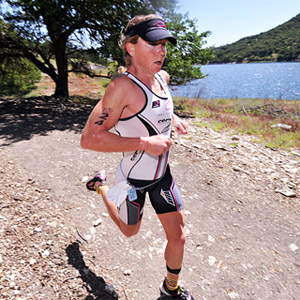
ST: To some critics, going with Brett Sutton as your coach after suffering some overuse injuries and overtraining syndrome would not be not the best remedy.
Mary Beth: You look at the way he trained Loretta Harrop [the 1999 ITU World Champion and 2004 Olympic silver medalist] who was one of the most injury-prone triathletes. I think Brett Sutton is really good with injury-prone athletes. I think athletes themselves are more self-destructive. You need a coach to keep you from destroying yourself.
ST: Why did you think he was right for you?
Mary Beth: I listened to Brett give a talk and it made a lot of sense. And the timing was right. And if you want to be on his squad, you have to take on all of Team TBB’s sponsors. I had been dropped by most of my sponsors — and I was at a point where I figured I had one last good shot at big wins and I didn’t want to regret not trying.
ST: When did you first start training with Sutton?
Mary Beth: In February 2011 I went to the Team TBB camp in Thailand.
ST: What was it like?
Mary Beth: It is a little scary flying over to Thailand. But it was great. I learned a lot in the first few weeks. He made some changes to my running and my swimming form. Just small little tweaks that cured some of the things that had been aggravating my injuries. In running, we focused more on cadence. I am a short person [5 feet 4 inches] and there's no reason to take huge galumphing strides.
ST: Cadence is king?
Mary Beth: Caitlin Snow is small and she has such an amazing (rapid) cadence. [Snow ran 2:53 at Kona this year] Especially when you get to the Ironman, a fast cadence is definitely where I have to go. When you are tired you can’t take big powerful strides. You have to rely on cadence.
ST: Were you afraid of injuries going with Sutton?
Mary Beth: I was a little bit broken down going in. Turns out he is more conservative than I would ever be with myself. I came in feeling that I was a little tweaked. After two weeks, I had no problems. It was great.
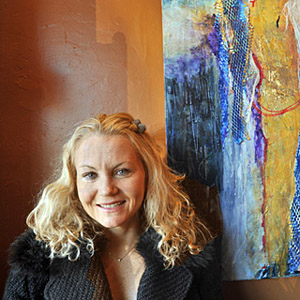
ST: When did you hit good form?
Mary Beth: I started to feel better right away. I won Singapore 70.3 and I had a great race at Wildflower [2nd behind Leanda Cave]. Then I was pretty happy with my first Ironman.
ST: You say it very modestly. But your performance at Ironman Austria made you the woman with the third fastest Ironman PR on the planet, You finished Austria in 8:43:35 — which put you behind only Chrissie Wellington (8:18) and Rebekah Keat (8:39) on the all-time women's list.
Mary Beth: Austria is a fast course.
ST: Some said you were on pace to go even faster than your 8:43. What happened?
Mary Beth: The elephant jumped on my back with about 10k to go.
ST: For a normal person the last 10k is rough. But with that spectacularly fast time?
Mary Beth: I think I was on 2:55 marathon pace. Then I struggled and finished around 3 hours and change [3:01:25]
ST: Were you aware how fast you were going?
Mary Beth: I didn’t wear a watch. The whole day I was unaware. It is the kind of thing you can’t wrap your mind around it right away. I was still in shock for some time after.
ST: Did you feel you have found a home at the distance?
Mary Beth: Yes. It had been the trend that I would do better the longer the race. I did better against the rest of the girls in the half marathon than at I did at 5k and 10k. But the Ironman it is a hard day out there.
ST: Canada was a tougher course and there was a reason Erin Baker is a hall of famer and that her course record lasted 21 years until you broke it. So which of those two performances – Austria or Canada – gave you the most satisfaction?
Mary Beth: I think Canada. At Austria I was just totally green. You are just kind of going through it and afterwards you think, ‘Wow! That was easier than I thought.’ In Austria, I had people around the whole time and plenty of crowds, whereas in Canada they started the women half an hour ahead and it was windy, hot and lonely the whole day. I think I biked a little too hard in Canada so I was tired when I started the run and really struggled the last 8-10 miles.
ST: After those two races and Ironman Regensburg, what kind of hopes did you have for Kona?
Mary Beth: I was actually pretty optimistic. But when I look back on Kona, I cringe. I had a bad swim, a really bad bike, and then there was nothing all that redeemable other than finishing. In the swim I was with the front group and got kicked in the head. The next thing I knew I was pretty far back from the leading women. On the bike I was throwing up. Finally I was able to get food in. Then I got a flat around the 100 mile mark and tried to fix it. It went flat again with a few miles to go. I rode in on the flat and I was drained for the run.
ST: What can you do to avoid that in 2012?
Mary Beth: We didn't plan for Kona at the beginning of the year. So I didn't start to look at points until after Austria. I think with a little better planning I should not have to do three Ironmans to qualify. The goal should be to do two and Kona. Sure one Ironman and Kona is in some ways better. But I am not going to be in this sport forever. So I would not mind trying to do as many races as I can.

